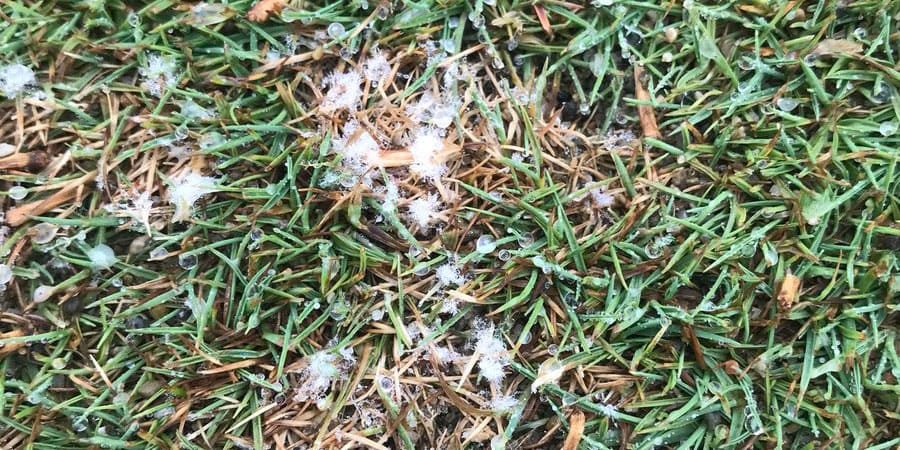Dollar Spot

Dollar spot is easily one of the top diseases superintendents have to combat each year in this part of the country, and it can be seriously destructive to playing surfaces. Harry Helsel, ATS Sales Rep, relates one memorable and destructive encounter he had with dollar spot.
“The worst case of dollar spot I have ever encountered happened when a spray technician forgot to spray a green in the normal rotation and the green did not receive fungicide for a 28-day window. A ball could not roll on that green more than 3 inches without hitting a dollar spot scar. It took the golf course superintendent 6 weeks to get that green back to normal playing conditions.”
The fungal pathogen behind this foliar disease that can cause so much destruction is Sclerotinia homoeocarpa. Sclerotinia homoeocarpa survives in infected plants and plant debris. The fungal pathogen spreads through mycelium and distributes by wind, water, shoes, and turf maintenance equipment (like a mower). In cases of dollar spot with a high severity, the infected areas combine to create larger infected areas. Proper cultural practices and chemical controls are important to help minimize the intensity of dollar spot.
Cultural Practices
Retaining sufficient nitrogen when dollar spot becomes active with the rising temperatures in the spring is important. To do this, perform frequent and light, quick-release nitrogen fertilizer applications in late spring. When nitrogen is available fast, it’s more probable to see a quick surge of growth, followed by a hungry plant a few days after the application. Foliar-Pak 14-2-4, 11-0-11, Grow-In, Amperage, Bio 12-6-6, and 30-0-0 are tools in your toolbox you can use to add nitrogen and create a healthy plant, which then help it prevent and recover from dollar spot infections.
Incorporating phosphites into your battle with dollar spot can have several beneficial impacts on turf that would have a causal effect on battling dollar spot. Morgan Timberlake, Director of Golf Sales for ATS says, “Phosphites stimulate the plant’s Systemic Acquired Resistance (SAR), which secretes enzymes that have an impact on some pathogens.” He also adds that phosphites can be used in photosynthesis, chlorophyll production and the thickening of cell walls and all of these factors create a stronger, more resilient plant, which then give it a stronger chance of fighting off dollar spot.
A few other cultural practices that will reduce dollar spot severity include irrigation, removing dew, and maintaining sharp mowing blades. Irrigating deep and intermittingly in the early morning and nighttime will reduce leaf wetness and lessen an outbreak of dollar spot. Removing dew by utilizing practices, like mowing or poling in the early morning, will also minimize a dollar spot outbreak. In addition, it is very important that your mowing units are sharp and delivering a good cut on the turfgrass to minimize dollar spot infection.
Chemical Control
Dollar spot is a disease where constantly having to battle it is a real possibility. However, keeping dollar spot at a manageable level throughout the season is attainable with sound cultural practices and the help of preventative and curative fungicide applications. Craig Shepherd, ATS Sales Rep in the Chicagoland area explains the importance of preventative applications: “You do not to want to wait to spray until a dollar outbreak has occurred. Controlling inoculum is the absolute key to this disease.”
When applying fungicides, be sure to select the proper spray nozzle and volume of water for uniform coverage. The fungicides below are good options for controlling dollar spot.
- ArmorTech Rotator at 0.5oz/1000
- BASF Xzemplar at 7oz/Acre for 14 days, 9.2 oz/Acre for 14-21 days, 11.4oz/Acre for 21-28 days
- Nufarm Pinpoint at 7.4-13.5 oz/Acre for 14-21 days
- ArmorTech Zoxy-T at 0.75-1.5oz/1000 for 7-14 days
Fungicides are not the only chemical control that can battle dollar spot. Scott Brame, ATS President, says growth regulators and penetrates are helpful aids when trying to control dollar spot: “Using growth regulators can be a huge help controlling dollar spot. The reduced growth prolongs contact fungicide application effectiveness. Also, consider using a light rate of a penetrate wetting agent. The penetrate will help reduce dew. A drier plant with a small, steady dose of fertilizer will be less prone to dollar spot.”







